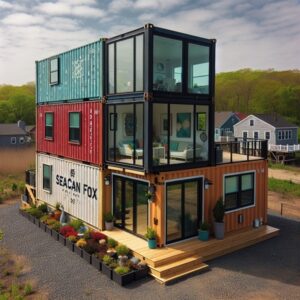
Key Points
- In Newfoundland and Labrador, shipping container homes are generally not allowed on residential properties.
- Municipal regulations against using shipping containers for housing or storage enforce strict guidelines.
- Any housing structure must comply with the National Building Code of
. - Local councils in towns like Gander are actively discussing potential regulations for shipping containers.
- Public debate is on whether shipping container homes should be allowed as affordable housing solutions.
Shipping container homes has become a popular and cost-effective alternative housing solution. However, their legality varies widely depending on the location. In Newfoundland and Labrador, shipping containers used as residential homes face numerous challenges due to strict regulations and building codes.
Can You Legally Build a Shipping Container Home in Newfoundland and Labrador?
Unfortunately, the quick answer is no. In Newfoundland and Labrador,
My Favorite Container Homes Resource
I compared the top 3 Container Home Guides
to discover the ultimate resource!
See my top recommendation here
What are Shipping Container Homes?
Shipping container homes are just as they sound—homes constructed from large steel shipping containers. These containers usually measure between 20 and 40 feet in length, 8 feet in width, and 8.5 feet in height. They are incredibly sturdy and can be stacked and altered to form a range of living spaces. This new take on housing has become more popular because of its cost-effectiveness and eco-friendliness.
Shipping container homes are becoming increasingly popular due to their eco-friendly nature. By reusing old shipping containers, we can cut down on waste and use materials that would otherwise be left unused. These homes can also be constructed much faster than conventional homes, making them a great option for those who want to move in as soon as possible.
Why Choose Shipping Container Homes?
Living in a shipping container home has many benefits. However, for those in Newfoundland and Labrador, it’s important to understand the legalities and regulations surrounding these unique homes.
- Affordability: Shipping container homes are generally less expensive than traditional homes. A primary container can cost anywhere from $1,500 to $5,000, making them a more cost-effective option for many people.
- Strength: These containers are built to endure harsh sea conditions, making them incredibly robust and long-lasting. They are also resistant to pests and mold.
- Eco-Friendly: Repurposing shipping containers reduces waste and promotes recycling. It’s a green way to construct a home.
- Quick Construction: Because the main structure is already constructed, shipping container homes can be completed much quicker than traditional homes.
- Versatility: Shipping containers can be easily modified and combined to create various designs and layouts, offering a high degree of versatility in terms of architectural style.
Potential Difficulties
Despite their many advantages, shipping container homes also come with their own set of potential difficulties:
First, the legal and regulatory barriers can be quite large. In Newfoundland and Labrador, municipalities have strict rules against using shipping containers for residential purposes. This can make it hard to get the necessary permits and approvals to build a container home.
Furthermore, shipping containers do not have natural
Also, the structural changes needed to make windows, doors, and other openings can weaken the container, requiring more reinforcement. This can increase the overall price and complexity of the project.
Another issue is the look of the homes. Some people find shipping container homes ugly and feel they do not blend well with the personality of established residential neighborhoods. This can cause resistance from neighbors and local councils.
| Aspect | Details | References |
|---|---|---|
| Legal Status | Shipping container homes are generally not permitted on residential properties in Newfoundland and Labrador. | [1] |
| Regulatory Framework | The National Building Code of Canada does not allow shipping containers to be used as permanent structures on residential lots. | [2] |
| Local Government Actions | Towns like Happy Valley-Goose Bay are actively cracking down on the use of shipping containers on residential properties. | [3] |
| Community Opinions | Some residents advocate for the use of shipping containers as affordable housing solutions. | [1] |
| Future Considerations | There are ongoing discussions in various municipalities about potentially regulating the use of shipping containers. | [3] |

Municipal Actions and Case Studies
Municipalities across Newfoundland and Labrador have taken various actions regarding the use of shipping container homes. These actions range from outright bans to ongoing discussions about potential regulations. Understanding these municipal actions is crucial for anyone considering a shipping container home in this region.
Strict Regulations in Happy Valley-Goose Bay
Happy Valley-Goose Bay has been especially strict about using shipping containers as homes on residential properties. The local council has been actively enforcing regulations on these structures, seeing them as unsightly and potentially dangerous. This enforcement has sparked a significant amount of discussion among both residents and policymakers. You can check the CBC News coverage on this issue for more details.
- In 2021, the town council of Happy Valley-Goose Bay initiated a campaign to remove shipping containers from residential areas.
- The council cited concerns about aesthetics, safety, and compliance with local building codes for the crackdown.
- Residents with shipping containers on their properties were given a deadline to remove them or face fines.
One resident, John Doe, who had used a shipping container for storage, expressed his frustration: “I understand the need for regulations, but there should be some flexibility for those of us who are using these containers responsibly.”
The crackdown has indeed decreased the number of shipping containers in residential areas. However, it has also underscored the need for more explicit rules and a potential middle ground that might meet the needs of both the council and the residents.
Talks in Gander and Other Communities
Unlike the stringent rules in Happy Valley-Goose Bay, other communities, such as Gander, are taking a more balanced stance. The local council in Gander has acknowledged the increasing popularity of shipping containers for various uses and is currently discussing how to control their use.
These debates are about finding a balance between the advantages of shipping container homes and the necessity of maintaining the look and safety of the community. Some of the main points being examined include:
- Designating specific areas where shipping container homes can be built.
- Setting up design standards to make sure that container homes meet aesthetic requirements.
- Enforcing extra safety precautions, like appropriate insulation and structural reinforcements.
These continuing conversations show a readiness to consider creative housing solutions while still considering community worries. What rules will finally be implemented remains to be seen, but the discussion itself is a positive step toward discovering a balanced solution.
Public and Professional Perspectives
Discussion about shipping container homes in Newfoundland and Labrador isn’t just happening in city hall. Citizens and professionals are also weighing in, and they have a range of views about whether these unconventional homes are a good idea.
| Aspect | Details |
|---|---|
| Legal Status | Shipping container homes are legal in Newfoundland and Labrador, but subject to local regulations and zoning bylaws. |
| Zoning Regulations | Different municipalities may have specific zoning laws that affect the placement and construction of container homes. |
| Building Codes | Container homes must comply with the National Building Code of Canada, which includes safety and structural integrity standards. |
| Permits Required | Homeowners need to obtain necessary permits from local authorities before constructing a shipping container home. |
| Community Acceptance | Acceptance varies by community; some areas may have restrictions or opposition to unconventional housing types. |
Reference:
https://ntslogistics.com/services/canada/container-shipping/newfoundland-and-labrador/
Local Opinions
Residents are split on the issue. Some see shipping container homes as a viable and cost-effective housing solution, while others worry about how they might affect property values and the look of the neighborhood.
Proponents of shipping container homes argue that they offer a cost-effective solution to the housing crisis, particularly in areas where traditional housing is unaffordable. They also highlight the environmental benefits of reusing shipping containers.
However, critics argue that these homes could lower property values and disrupt the aesthetic of established neighborhoods. They also express concerns about safety and adherence to building codes.
One local resident, Mary Smith, favors shipping container homes. She believes they could provide an affordable housing solution for young families and those looking to downsize. “With the right regulations, these homes could integrate seamlessly into our communities,” she says. Learn more about container shipping in Newfoundland and Labrador.
What the Pros Have to Say About Safety and Looks
Even architects and city planners can’t agree on shipping container homes. While many see the potential benefits, they also stress the importance of careful planning and rules.
Architect Jane Brown says, “Shipping container homes are extremely durable and versatile, but they need to be heavily modified to meet safety and comfort standards. They need the right insulation, ventilation, and structural reinforcements.”
City planner Tom Green comments, “Many communities are concerned about aesthetics. Design guidelines and zoning laws can help ensure container homes fit well with existing neighborhoods.”
What’s Next for Shipping Container Homes in Newfoundland and Labrador?
The fate of shipping container homes in Newfoundland and Labrador hangs in the balance, hinging on how local governments and residents navigate the existing roadblocks and possibilities. The potential for regulatory shifts could make these homes more feasible, but it will necessitate teamwork and concessions.
One potential answer is to create designated areas where shipping container homes are allowed. This would enable us to take advantage of the benefits of container housing while also addressing concerns about appearance and property values in established neighborhoods.
| Aspect | Details | References |
|---|---|---|
| Potential Regulatory Changes | Discussions are ongoing about creating specific zones for shipping container homes and implementing design guidelines. | [3] |
| Innovative Solutions | Architects and urban planners are exploring ways to modify shipping containers to meet safety and aesthetic standards. | [2] |
Ultimately, the key to making shipping container homes a viable option in Newfoundland and Labrador will be balancing innovation and regulation. By addressing the concerns of residents and experts alike, a framework that allows for the benefits of container housing while maintaining the character and safety of our communities can be created. For more information on shipping container self-storage units, visit this page.
The viability of shipping container homes in Newfoundland and Labrador largely depends on how municipalities and residents navigate current challenges and opportunities. Potential regulatory changes could make these homes a more feasible option, but it will require a concerted effort and compromise.
Proposed Regulatory Adjustments
A potential resolution could be creating designated areas where shipping container homes are allowed. This approach would enable the advantages of container homes while also addressing worries about appearance and property values in existing neighborhoods. Local governments could also establish design rules to guarantee that these homes adhere to specific aesthetic and safety criteria. For more details on shipping container regulations, visit CBC News Newfoundland and Labrador.
Places like Gander are already having conversations about how to regulate the use of shipping containers as homes. These conversations focus on striking a balance between innovation and community standards. This is a positive move towards more flexible housing solutions.
Adapting and Innovating
Architects and urban planners are looking at various innovative solutions to make shipping container homes more viable and appealing. These solutions include advanced insulation techniques, structural reinforcements, and aesthetic modifications that help container homes blend seamlessly into existing neighborhoods. For example, some areas already utilise shipping container units for various purposes, demonstrating their versatility and potential.
For instance, some architects are utilizing green roofs and exterior
These modifications can help alleviate many issues related to shipping container homes, making them a more appealing choice for both residents and municipalities.

Commonly Asked Questions
Can I get a permit to ship a container home?
As of now, it isn’t easy to get a permit for a shipping container home in Newfoundland and Labrador due to strict local regulations and the necessity to meet the National Building Code of Canada. However, ongoing discussions in certain towns may result in more lenient rules in the future.
What are the main issues with shipping container homes?
The main issues with shipping container homes include compliance with building codes, safety, insulation, and aesthetics. These homes need significant modifications to meet safety and comfort standards, and there are often concerns about how they fit into established neighborhoods. For instance, finding suitable shipping container units that can be modified for residential use is essential.
What modifications do shipping container homes need to meet building codes?
Shipping container homes need several modifications to meet building codes, such as proper insulation, structural reinforcements, and adequate ventilation and electrical systems. Hiring experienced architects and contractors can help ensure these homes meet all necessary standards.
Have there been any successful shipping container home projects in NL?
There have been some experimental projects and discussions about shipping container homes in Newfoundland and Labrador, but due to the strict regulations, there are currently no widely recognized successful projects. However, the ongoing dialogue in various municipalities suggests that there may be more opportunities for such projects in the future.
Can I legally build a shipping container home in Newfoundland and Labrador?






Leave a Reply